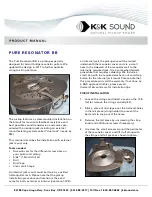
R E V . A 10 9/ 9 8 P N 47653
H U M P H R E Y F I E L D A N A L Y Z E R
I I
A-22
APPENDIX A
REV. B 02/03 PN 51680-1
HUMPHREY FIELD ANALYZER
II -
i
series
The original Humphrey Full Threshold testing algorithm measured patient response time and
made small adjustments to test pacing. SITA takes this idea much further using patented timing
techniques. It is extraordinarily responsive to patient reaction times. One way to think about
SITA is that
the patient runs the perimeter, rather than the reverse.
3. SITA Knows When to Quit
Student doctors are often given a list of questions to ask while taking histories. At first they will
adhere to that list, even when they already have more than enough information to make the
proper diagnosis. Later on, they start learning when to stop, and they also develop a sense of
when to probe further on issues which the patient did not make clear enough.
SITA does the same thing. SITA knows when enough is enough. The standard Full Threshold
algorithm used in the Humphrey Field Analyzer II crosses the threshold twice. It quits only
after the answer is near what is expected. When the answer is different from the expected
value, the measurement is repeated—again crossing the threshold twice.
Using such fixed criteria, sometimes too much information is gathered, and sometimes not
enough.
SITA computes when to stop testing at each location, based on a patented “informa-
tion index.” This technique allows the instrument to spend extra time at test locations where
SITA is unsure about the result, and to spend less time at locations where the answers are
highly consistent.
When the information index reaches a predetermined value, testing at that point is discontin-
ued—the point is then closed
.
The information index depends not only on patient responses at
that location, but also on responses to stimuli presented at other locations nearby. Thus, it is
possible that a test point residing in a part of the visual field where all measured thresholds
were more or less in agreement might be closed earlier than a test point in a more variable
region. This might happen even if the responses at these two test points were otherwise
identical.
4. SITA Carefully Recalculates All Threshold Values at the End of Testing
Experienced doctors tend to be very skilled at putting the puzzle together. At the end of the
examination, they assess all of the information and make a diagnosis which is consistent with
all of the available data. SITA does the same thing, ignoring nothing. At the end of the test it
thinks the problem through, completely, one last time.
The original Humphrey algorithm—and other methods in current use—base the calculated
threshold on the last apparent crossing of threshold. All answers leading up to that final
crossing are ignored, and all answers at adjacent points are ignored as well. Such an approach
is highly vulnerable to patient response errors.
SITA looks at the complete pattern of patient responses at each tested point. During the test all
responses are considered, not just the last seen value. At the end of the exam, SITA again
considers the totality of the responses at each point and recalculates the whole field result to
produce a further refinement of its measurements.
G-2
APPENDIX G
B-H Appendex.htp
3/14/03, 3:23 PM
22
Содержание HUMPHREY 720i
Страница 1: ...HUMPHREY FIELD ANALYZER II i series USER S GUIDE Model 720i Model 740i Model 745i Model 750i...
Страница 4: ......
Страница 26: ...1 18 INTRODUCTION INSTRUMENT SETUP REV B 02 03 PN 51680 1 HUMPHREY FIELD ANALYZER II i series...
Страница 116: ...6 8 TEST RELIABILITY REV B 02 03 PN 51680 1 HUMPHREY FIELD ANALYZER II i series...
Страница 208: ...10 20 CUSTOM TESTING REV B 02 03 PN 51680 1 HUMPHREY FIELD ANALYZER II i series...
Страница 284: ...12 14 CARE AND CLEANING REV B 02 03 PN 51680 1 HUMPHREY FIELD ANALYZER II i series...
Страница 327: ......
Страница 328: ......
















































